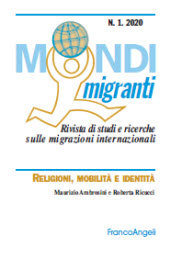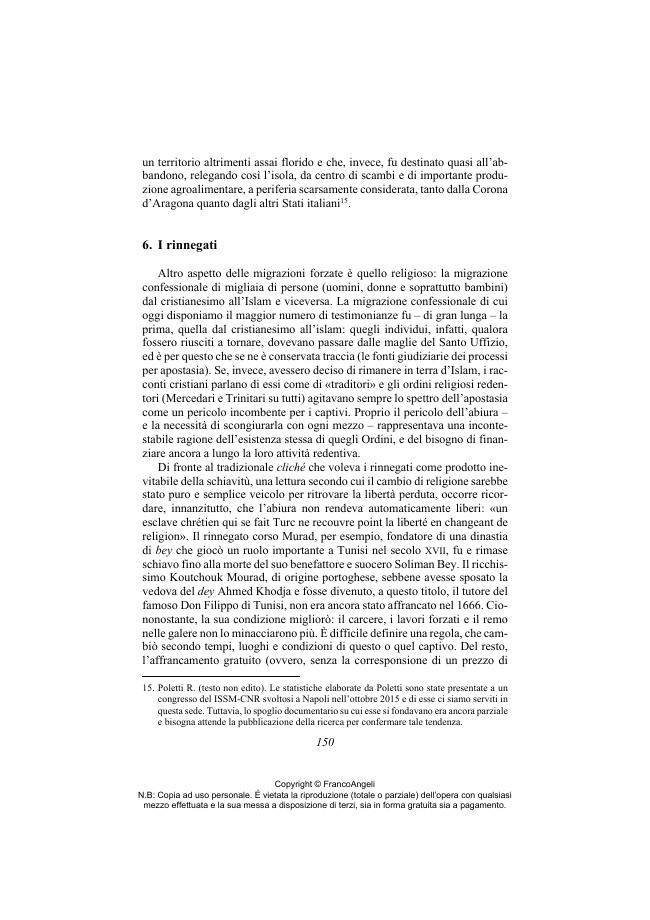Migranti, schiavi, rinnegati : mobilità e traffico di esseri umani nel Mediterraneo di età moderna (secoli XVI- XVIII)
137-162 p.
Inserendosi nell'ambito degli studi sulle migrazioni (campo - non occorre dirlo - amplissimo), il saggio qui proposto intende portare l'attenzione su un particolarissimo tipo di migrazione in età moderna: la migrazione "forzata" che riguardò migliaia di uomini e donne, tratti in schiavitù sull'una o l'altra sponda del Mediterraneo, scambiati come merce, venduti e trattati alla stregua di ogni altra derrata. Questo fenomeno, seppur sotto forma di un lento stillicidio, sul lungo periodo assunse i caratteri di una "deportazione" forzata e massiva.
Secondo alcuni storici, infatti, nei tre secoli dal 1520 al 1820 furono più di un milione e duecentomila i cristiani catturati da pirati e corsari e ridotti in schiavitù solo sul versante maghrebino (nelle città costiere di Algeri, Tunisi e Tripoli, allora formalmente vassalle dell'Impero ottomano) e forse altrettante a Istanbul. Se si considerano anche tutti i musulmani razziati da navi cristiane e ridotti in schiavitù in Europa, alcune stime suggeriscono che il numero complessivo di schiavi e captivi, su entrambi i versanti, potrebbe ascendere a oltre due milioni e mezzo.
Tale fenomeno di deportazione massiccia produsse altri fenomeni collaterali, alcuni migratori in senso fisico, come lo spopolamento in vaste regioni costiere della Sardegna a partire dalla prima età moderna, altri migratori in senso "confessionale", come dimostra il gran numero di rinnegati (cristiani convertitisi all'Islam in terre musulmane), molti di essi ex schiavi (ma non tutti, come si dirà nel saggio) che intendevano in tal modo migliorare le proprie condizioni di vita e, magari, tentare la fuga per fare ritorno in patria. Ma la schiavitù mediterranea tra Cinque e Settecento ebbe soprattutto forti implicazioni economiche. Tale fenomeno, alimentato e reso possibile in grandissima parte da un'attività violenta e dai contorni legali incerti - tanto da fare parlare spesso indi-stintamente di guerra da corsa e di pirateria -.
determinò la nascita e lo straordinario sviluppo, tra primo Cinquecento e oltre la metà del Settecento, di un vero e proprio settore economico che la storiografia recente ha definito, con una fortunata espressione, il «commercio dei captivi». Quel traffico di esseri umani attraversò frontiere religiose, politiche e giuridiche e fu caratterizzato da un indice di rischio elevato, a causa della natura delle transazioni, che si svolgevano in un contesto di ostilità o di violenza latente. Malgrado ciò, non si trattò di un insieme di operazioni isolate e contingenti, bensì «d'un commerce pérenne et régulier». L'attività di riscatto degli schiavi o captivi, sua diretta conseguenza, costituì, data la natura della merce scambiata, un settore economico straordinariamente lucrativo: riscattare schiavi era un affare, che prometteva guadagni considerevoli e attirava attori da ogni parte del Mediterraneo. [Testo dell'editore].
Within the riche field of migrations studies, the hereby proposed essay aims to focus the attention on a very peculiar kind of migration in the early-modern age: the "forced" migration that attained thousands of people, men and women who were captured and kept as slaves on both Mediterranean shores, sold as merchandise and bought or exchanged just like any other good. Even if proceeding little by little, on the long period this phenomenon acquired the characters of a compelled and massive "deportation".
According to some historians, along the three centuries from 1520 to 1820, more than 1 million and 200 thousands of Christians were captured and enslaved by Moorish pirates and corsairs and carried to the maritime cities of the Maghrebi shore (Algiers, Tunis and Tripoli, then formally vassals of the Ottoman Empire) and maybe to Istanbul as much. If we consider as well the high number of Muslims who were enslaved by Christians and sold to privates or kept as voguers on Europeans ships and galleys, the estimations of the global number of slaves and captives in the Mediterranean area could rise the two and half millions of people.
Such phenomenon of a massive deportation produced others collateral ones: some of them, migrations in a physic sense " such as the depopulation of a wide regions of Sardinia starting from the early modern age " while others were "confessional" migrations, as it is demonstrated by the high number of renegades (Christians converted to Islam while staying in Muslims dominions). Many of them were exslaves (although not all of them, as I explicate within the essay) who by this mean intended to get their living conditions betters, and if possible, trying to escape and return to their homeland. But the Mediterranean slavery between XVI and XVIII centuries also engendered deep economic implications.
This phenomenon indeed, provoked the emergence and the extraordnary development of a truly economic branch, that the recent historiography has defined, with a successfully expression, the «economy of the ransom». The commerce of the captives was really a traffic of human beings who crossed political, religious and juridical frontiers and became a regular and profitable commerce. The essay that hereby I propose intend to shed light on this phenomenon, considering it at the same time as a cause and a consequence of one of the most important and massive "forced" migration in the Mediterranean early modern history. [Publisher's text].
Fa parte di
Mondi migranti : 1, 2020-
Articoli dello stesso fascicolo (disponibili singolarmente)
-
Informazioni
Codice DOI: 10.3280/MM2020-001008
ISSN: 1972-4896
PAROLE CHIAVE
- Schiavitù, migrazioni, deportazioni, traffico di esseri umani
- Slavery, migrations, deportations, trafficking of human beings



